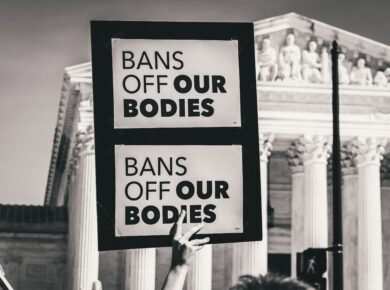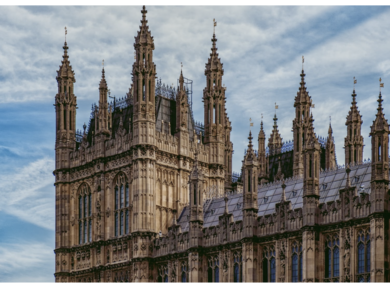By Harriet Bradley
On the 26th March 2014 the Royal College of Art (RCA) held the last of their ‘Sustain Talks’ series, on ‘The Rights of Nature and the Nature of Value’, about how and why we value and protect the natural environment and what the implications are for environmental ethics and governance. Dr Demos, art historian and cultural theorist, UCL History of Art faculty, spoke about art’s role in environmental activism and conflict. The rest of the panel included author and policy director Andrew Simms of the New Economics Foundation and Global Witness and Polly Higgins, the international environmental lawyer and author of Eradicating Ecocide. I caught up with Dr Demos at UCL to elaborate more on the themes of political ecology, eco-aesthetics, Earth Law and what art and political science might have in common.
Q: Could you explain the idea of the ecology of politics or political ecology?
A: It’s a very complex term, one with which I’m very occupied in my current research on a new book on contemporary art and political ecology. On a basic level it’s a term that insists on reading ecology in a political way- so ecology isn’t simply about ‘green living’, or ‘green design’ in a way that doesn’t challenge some of the basic premises of the political, economic and social world that we live in. The term is used in the discourse of Bruno Latour, the French Science Studies scholar, who in his book Politics of Nature, talks about how we can’t allow decisions related to climate change or global warming or ecological crisis to be left to the ‘experts’ alone, whether that means scientists, or politicians working in policy, NGOs or organisations like the UN. In other words it’s a process of breaking down the hierarchies that exist today in relationship to the decision-making about the environment; so that the views of all citizens, all people, and in fact all life forms should be taken into account in what Latour calls a ‘new ecology of politics.’ It becomes very experimental and increasingly speculative the more you get into it – such as what does it mean for a non-human life to have a legal stake and to express a political view?
Q: You’ve talked about Marxist approaches being influential, how do they interpret the global system and how does that relate to the environment?
A: The development of ecological thinking within Marxism has been reanimated in the last decade or so, coming after a longstanding view that Marx and Marxists had very little interest in ecology- that they were much more interested in industrial development, labour and modernisation- as in the context of the Soviet Union. While Soviet ecology was certainly disastrous after the 1920s, there’s a lot of really interesting recent revisionary scholarship on Marx, like John Bellamy Foster’s Marx’s Ecology. There are also others today working out of a critical framework in different fields, like Kevin Anderson, professor of Energy and Climate Change and Director of the Tyndall Energy Programme at Manchester, Chris Williams, an ‘eco-socialist’ coming out of science, and Richard Smith, a policy analyst, and Naomi Klein who’s an activist, among others who address ecology from a non-capitalist or post-capitalist position. But there’s a fundamental argument among such writers and speakers and activists that advanced capitalism is simply not really in a position to solve the problems that it has created; we have to think outside the automatic assumptions that we can only address the crises of ecology through market mechanisms.
If you look back on the history of ‘green capitalism’ – of the process since the nineties where capitalism has increasingly started to take on board environmental imperatives in relationship to its ways of operating – that has really not led to any substantial reduction of greenhouse gas emissions, or destruction of the environment in general. So a growing number of people are now arguing that the only real way of approaching the problem is to question the fundamental tenets of capitalism – basically the ‘growth economy’ – the idea that we can address ecological crises through mechanisms like sustainable development. Which really has been a compromised discourse – putting together ecological imperatives with demands for the continual accumulation of profits and wealth. Sustainable development ultimately means the sustaining of economic development above all else and that’s the problem and that’s why it’s not getting anywhere.
Q: What is the role of art in those debates, and specifically ‘eco-aesthetics’?
A: For me, art is part of a wider realm of aesthetic experience- of the visual and auditory – that has certain political dimensions in terms of how appearance is organised and in terms of questions of what is worthy of reproduction, dissemination and publication in the wider sphere of media, including but not limited to art. These kinds of questions end up delimiting the spaces of what can be deemed important and newsworthy on the one hand and what is a non-starter or reduced to noise on the other. The politics of aesthetics has to do with questions of appearance and where appearance is taking place and how we can challenge that division of the sensible. The philosopher Jacques Rancière writes about this in interesting ways.
Art is one mode within the larger sphere of aesthetics. It’s important to situate it in that larger context of things like new media, of governmental publicity, of scientific discourse, of filmmaking, of television. Eco-aesthetics proposes a way of understanding that realm of appearance where ecological discourse is addressed and processed in different ways. We shouldn’t reduce art to a kind of illustration of science which is the least interesting way of understanding what this category of practice is. Instead we should view it as a platform of interdisciplinarity, of collaborations, of experimental creative thinking. It’s a place where people can propose both criticisms of the present world order and its relationship to economic governance, social and political forces, and can also offer creative alternatives to those fields, through forms of ecological sustainability, or ways of living- in a radically democratic way, or according to non-capitalist exchange and an economy of sharing. Those are a variety of different and interesting ways that art can play a role in how we think about ecology and the ecological crises that we’re confronting.
Q: What art have you looked at in East India?
A: As you know, I’ve recently returned from a research trip to India, where there’s a long history of environmental destruction and ecological social movements, really going back to the time of early to mid twentieth century decolonisation. This was an important aspect to Ghandi: to develop a form of ecological independence against the forces of British colonialism and the foreign control of resources and production, which he contested in localist and non-violent ways. This continues today in relationship to corporate neoliberalism as it has been adopted and implemented in India since the early nineties. It comes up in East India in relation to corporate mining ventures that are very interested in extracting valuable minerals like bauxite (the basis of aluminium) that are located in the mountains in very biodiverse areas, like the states of Odisha and Chhattisgarh. The problem is that there are a number of indigenous groups that live in these areas and are integrally attached to the environment, to the biodiversity of life that exists there. So when a mining company (like Vedanta) comes in and wants to do mountain-top removal and surface mining in these regions, they end up bringing about the displacement of people and initiating a very anti-democratic, even violent, process. This is made possible largely through governmental collusion within the system of military neoliberal extractivism – the process of creating corporate enclaves where Indian and transnational corporations can go in and conduct mining enterprises which are damaging to the environment, to the mountains, to the forest and to the water supply.
Indigenous people like the Dongria Kondh who live in one area of Odisha, have turned their struggle into an international movement. They’ve been there for generations, and one of the things that came up in the Sustain Talks for me, was a conflict over the meaning of the ‘value’ of nature. For mining corporations and many businesses it’s about economic value. So they see the bauxite in the mountains as a vehicle of modernisation and development and bringing economic benefits to a large amount of people. Critics argue that that’s not exactly the case because it’s mostly about creating wealth for an elite few. The Dongria Kondh would say the value of the mountains supports their whole religious, cultural and material form of life. So when mining companies offer them the benefit of economic modernisation, their response is: ‘we can’t eat your money’. They don’t want to accept the offer of being displaced from their ancestral homeland and giving up their agricultural livelihood, in order ultimately to take a job in a mining factory- which is what they’re being offered. For some Indian politicians, this represents the benefits of modernisation, and modernising a so-called ‘backwards’ people. For the Dongria Kondh and many artists and activists who are now part of this struggle, this is part of a neo-colonial movement of resource expropriation.
Q: How have they used art in this struggle?
A: There are numerous examples of how artistic practice enters into the conflict. One is Sanjay Kak, an Indian filmmaker who made a documentary film that came out last year called ‘Red Ant Dream’ about the conflict in Odisha and Chhattisgarh and the conditions of the indigenous and village-based insurgency by people who are called variously the Maoists or the Naxalites; people who are taking up arms in opposition to the Indian state. It’s a violent conflict, what some people call India’s ‘war on terrorism’ at home. Although terrorism is a very difficult and complex term, and is usually used in very ideological ways – to discredit the Maoists, Kak’s film gives visual access to the complexity of the conflict and it counters a lot of corporate media and governmental propaganda that tend to dismiss the Maoists as basically terrorists or communists who have no legitimacy. The film opens up the immense hardships that they’ve faced that have led them into armed struggle: such as being forcibly displaced, living with continual police violence and what some see as a form of internal colonialism, which includes things like torture rape and extra-judicial killings as a strategy of getting people to leave their land so that they can open up the land for mining.
Another artist that I’m interested in is Amar Kanwar, who’s been working on the conflict in Odisha for a while now. One of his installations is called The Sovereign Forest, which was shown recently in the UK in the Yorkshire Sculpture Park. He also has a permanent installation in Bhubaneshwar in Odisha, a multi-media work with photographs and documents and film that offers a picture of the conflict, largely seen through the human costs to indigenous and village-based people in the area. It differs from Kak’s work in that it’s not so much about the Maoist armed struggle of resistance – it’s not in any way sympathetic to that struggle as Kak’s film is. Kanwar’s work is more about: how can we create a third space of independence, of democratic deliberation between diverse stakeholders in this very difficult conflict between on the one hand government repression and the police state, and on the other hand the Maoist insurgency and their turn to violence too, which propels this cycle that has been very destructive for all involved? One of the things that is really interesting in his permanent installation in Bhubaneshwar is a display of seeds– around 272 varieties of seed that are all indigenous Indian varieties contributed by a local farmer called Natabar Sarangi, who has taken up organic farming in order to resist the pressure of corporate agribusiness and GMO patenting of seeds. For Kanwar this is a model- a way of producing a material organic platform for a form of sovereignty and independence, rendered in a very aesthetically moving way in his installation, through the use of film, handmade books, and an archive of seeds made visibly present.
Q: So it acts a form of direct action that’s non-violent?
A: Yes, absolutely. In that sense it connects to a Ghandian tradition of non-violence. As well, it offers a model of the politics of aesthetics, wherein Kanwar’s work and Kak’s film both provide innovative ways of organizing appearance, giving those who have had no place in media representations a part, in effect constructing a new ecology of politics.
Q: Could you explain the idea of Earth Law and the rights of nature?
A: In relationship to the post-green revolution’s adoption of organic agriculture in India, one of the key writers and activists on behalf of that struggle is Vandana Shiva. She’s also been connected as an international activist to the developments in Earth Law and the so-called ‘rights of nature’, which have been implemented in the constitutions of Bolivia and Ecuador. Those governments have recognised the importance of creating legal means to protect the environment by formalising the standing of environmental subjects and non-human life forms in their legal code, so that the interests of the environment and its right to a continual biodiverse sustaining existence is recognised in courts of law.
That’s different from past legal ways of protecting the environment which are largely about protecting peoples’ rights to continue to exploit the environment. For example take the BP oil spill in the Gulf of Mexico, people in the US can sue the corporation on the basis that BP has taken away their ability to fish there – displacing their own right to economic exploitation of the environment. As a legal means of protecting the environment it’s quite problematic.
The new laws in Bolivia and Ecuador say that the environment has an intrinsic right to exist, and is no longer valued according to its human usefulness. That’s leading to various legal battles, around for example the history of oil spills in the Ecuadorian Amazon that have negatively affected the natural ecology (as well as the environment of indigenous groups like the Serayaku), which is being explored by artist-researchers like Paulo Tavares who has done a work called ‘Non-human Rights’, as part of a group exhibition called ‘World of Matter’ that deals with exactly these current eco-legalistic environmental conflicts in Ecuador. Here again art offers an intriguing platform for addressing the interdisciplinary, experimental, and speculative aspects of political ecology, forming a space of creating thinking (e.g. about law, indigeneity, economics, and aesthetics) that doesn’t really exist in very many other places.
One of the things that was fascinating at the RCA conference was Polly Higgins saying that it’s not enough to enact rights of nature discourse, because this can potentially lead to a system wherein we recognise the rights of nature but don’t have any real means to protect those rights. So she wants to add ‘ecocide’ to the international code of law which would provide a mode of governance to enact the rights of nature: so that if they are breached by whichever corporate industrial practice, those corporations can be tried in criminal courts of law for destroying the environment.
Q: It’s interesting that nature is frequently separated within discourses from the economy, but that these sorts of ideas about nature’s legal status, have quite revolutionary economic implications- its about changing the system that has led to this destruction of the natural environment.
A: Absolutely- in effect it’s a legal revolution in what’s call Earth Law or Earth Jurisprudence. And there’s already a number of books on it- like Cormac Cullinan’s ‘Wild Law’; it’s not only happening in Ecuador and Bolivia, it’s really international. And there are elements of this happening everywhere, basically shifting the legal system from a system of law based on territory and property rights and human interests, to a biocentric legal system – to return to Latour’s new ecology of politics – so we’re not dealing continually with a subject-object relationship, where humans are subjects and so-called natural life forms are objects, but rather a system of political equality between people and non-human life, at least before the law. Now what exactly this means is obviously still quite speculative—hence the currency of the topic in experimental artistic research, which is often forward thinking—but it proposes a fascinating system and people like Cullinan have addressed some of these complexities in really interesting ways.







